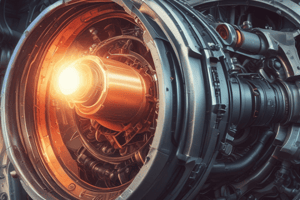Podcast
Questions and Answers
What exit do you use during a fire drill?
What exit do you use during a fire drill?
- Primary (correct)
- Secondary
- Front Door (correct)
- Hallway Door
Before you exit the classroom what do you need to do first?
Before you exit the classroom what do you need to do first?
- get personal belongings (correct)
- face to name (correct)
- get coats for children
- phone
What do you do during a bomb threat?
What do you do during a bomb threat?
- Throw the red disc under door to hallway (correct)
- hang up on the bomber
- use a cell phone (correct)
- use the walkie
If a child gets left behind you do what?
If a child gets left behind you do what?
Which of the following is NOT a component of the fire triangle?
Which of the following is NOT a component of the fire triangle?
If there's a tornado warning you do what?
If there's a tornado warning you do what?
Which fire stage is characterized by smoldering and a small amount of smoke?
Which fire stage is characterized by smoldering and a small amount of smoke?
Where is our secondary meeting location?
Where is our secondary meeting location?
Flashcards are hidden until you start studying
Study Notes
Definition and Composition
- Fire is the rapid oxidation of a fuel source, resulting in the release of heat, light, and various products of combustion.
- Fire is a chemical reaction that involves the combination of fuel, oxygen, and heat.
Stages of Fire
- Incipient stage: The initial stage of fire, characterized by smoldering and a small amount of smoke.
- Growth stage: The stage where the fire spreads and grows, fueled by more oxygen and combustible materials.
- Fully developed stage: The peak stage of fire, characterized by intense heat, flames, and a large amount of smoke.
- Decay stage: The final stage of fire, where the fuel is depleted, and the fire dies out.
Fire Triangle
- The three essential elements required for a fire to start and sustain:
- Fuel: The material that undergoes combustion (e.g., wood, gasoline, propane).
- Oxygen: The oxidizer that supports combustion (typically atmospheric oxygen).
- Heat: The energy source that ignites the fuel (e.g., flame, spark, hot surface).
Fire Types
- Class A: Fires involving ordinary combustible materials (e.g., paper, wood, cloth).
- Class B: Fires involving flammable liquids or gases (e.g., gasoline, propane, oil).
- Class C: Fires involving electrical equipment (e.g., appliances, wiring, circuit breakers).
- Class D: Fires involving combustible metals (e.g., magnesium, titanium).
Fire Hazards and Risks
- Flashover: A sudden and intense increase in fire temperature, often causing a room to become fully engulfed in flames.
- Backdraft: A sudden explosion of flames that occurs when oxygen is reintroduced to a fire that has depleted its oxygen supply.
- Fire spread: The movement of fire from one location to another, often through convection or radiation.
Definition and Composition
- Fire is a rapid oxidation process of a fuel source releasing heat, light, and combustion products.
- Combustion requires three elements: fuel, oxygen, and heat.
Stages of Fire
- Incipient Stage: Initial phase with smoldering and minimal smoke.
- Growth Stage: Fire expands, fueled by increased oxygen and available combustibles.
- Fully Developed Stage: Peak intensity with high heat, flames, and significant smoke.
- Decay Stage: Final phase where fire diminishes due to fuel depletion.
Fire Triangle
- Essential components for fire ignition and maintenance:
- Fuel: Combustible materials like wood, gasoline, or propane.
- Oxygen: Typically from the atmosphere, supporting combustion.
- Heat: Energy source igniting the fuel, via flame, spark, or hot surface.
Fire Types
- Class A: Ordinary combustibles, including paper, wood, and cloth.
- Class B: Flammable liquids or gases such as gasoline and oil.
- Class C: Fires involving electrical equipment, like appliances and wiring.
- Class D: Fires that involve combustible metals, e.g., magnesium and titanium.
Fire Hazards and Risks
- Flashover: Rapid temperature rise causing a space to ignite fully.
- Backdraft: Explosive re-ignition of a fire when fresh oxygen is introduced.
- Fire Spread: Movement of fire facilitated by convection or radiation to other areas.
Studying That Suits You
Use AI to generate personalized quizzes and flashcards to suit your learning preferences.





